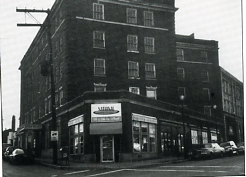
The Penn-Beaver Hotel in Rochester under construction.
Click Here to Return to Milestones

Over the course of the years, the Borough of
Rochester has had a total of eight fine hotels. Whether pursuing
cultural events at the famed Opera House or business as usual
for the commercial rail and steamboat trades, there had always
been available good food and lodging to suit any traveler's needs.
The last in this line of progression and the only one still standing
is the Penn-Beaver Hotel. Built in 1927 at a cost of $450,000,
the Penn-Beaver was designed to be a 90 room brick and steel building
of five stories. It was to include the full range of hotel amenities
from guest and meeting rooms to dining and banquet facilities.
The "Beaver Room" was reserved for breakfasts and luncheons,
while the main dining hall would serve dinners and banquets.
It was owned and operated by the Beaver Valley Community Hotel
Corporation. This company had as its Board of Directors many of
the most astute businessmen in Beaver County. Names such as Townsand,
Batchelor, Anderson, Barnett, Goetmann and Youtes, amongst others,
were to become indelibly etched into the history of Beaver County.
At the time of the Penn-Beaver construction there were four of
the eight hotels still in existence in various locations around
Rochester. Some hotels were located near the river to accommodate
the river traffic. Some were located near the railroad lines to
accommodate the rail traffic.
In an astounding decision, the board of directors chose neither
as their location. With the automobile still in its infancy, but
accurately recognizing its potential, the board chose as its location
one in close proximity to the major land routes criss-crossing
Beaver County, which would later become Routes 18, 51,65, and
68.
Regardless of where you were in Beaver County, if you wanted to
get to the other side of the county, you had to go through Rochester
and pass the Penn Beaver Hotel.
Then in a beautifully conceived advertising campaign the building's
owners chose to name the hotel through a "contest".
This contest was published throughout the county in the "The
Daily Times" and would be open to everyone.

Naming rights would go to the first place winner, as chosen by
the owners. There would also be a second place winner chosen.
The first place winner was Miss Eva B. Johnston of West Bridgewater,
who chose the name "Penn-Beaver," and received the grand
prize of $50 for her efforts.
The second place winner was Miss Maude F. McBrier of Freedom,
who chose the name "Ft. McIntosh" and received the runner
up prize of $25 for her efforts. Both prizes were tidy sums in
those days.
For the grand opening in 1928, a waltz was composed. It was written
by J. Abrinzo and John L. Robinison and played in the banquet
room at the opening ceremonies.
The Penn-Beaver enjoyed the spotlight as Rochester's premiere
hotel, dining and banquet facility for more than 30 years. Its
size, however, rendered it susceptible to the changing times.
As the years passed, the Opera House closed, river traffic moved
elsewhere, and passenger trains stopped running. Soon downtown
businesses moved or were forced to close by the new shopping centers
and malls. Thus the need for a hotel of this size diminished.
The Penn-Beaver has since changed hands on numerous occasions
and had a multitude of uses, not necessarily restricted to the
hotel business.
The building was sold to Michael Baker Jr., Inc. who used the
upper floors as its corporate headquarters until construction
was completed on their new buildings in Brighton Twp.
It was then sold to The Golden Age Apartments, Inc. whose plans
for the building included a senior retirement center.
The present owners, Dr. and Mrs. Mark Konrad, occupied the building
since the early 1980's. Dr. Konrad, until his recent retirement,
had used the building to house his own private medical practice
as well as to lease space to other medical practitioners.
The building still stands poised regally over the surrounding
structures. It continues to announce its existence by its roof
top sign that can easily be seen from the hilltops to the south
of the river.
As the last in the line of stately hotels serving the community
of Rochester, the Penn-Beaver quietly awaits its next owner; hopefully
to bring it back to the majesty it once possessed. Although the
need for a central hotel of this size has long since passed, the
Penn-Beaver is much too grand and historical a structure to follow
in the footsteps of the Oriental Theater.